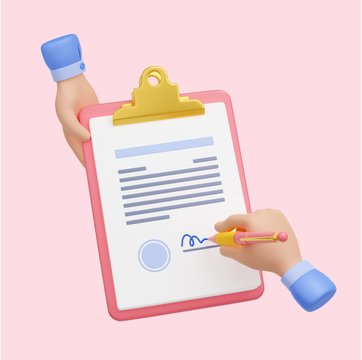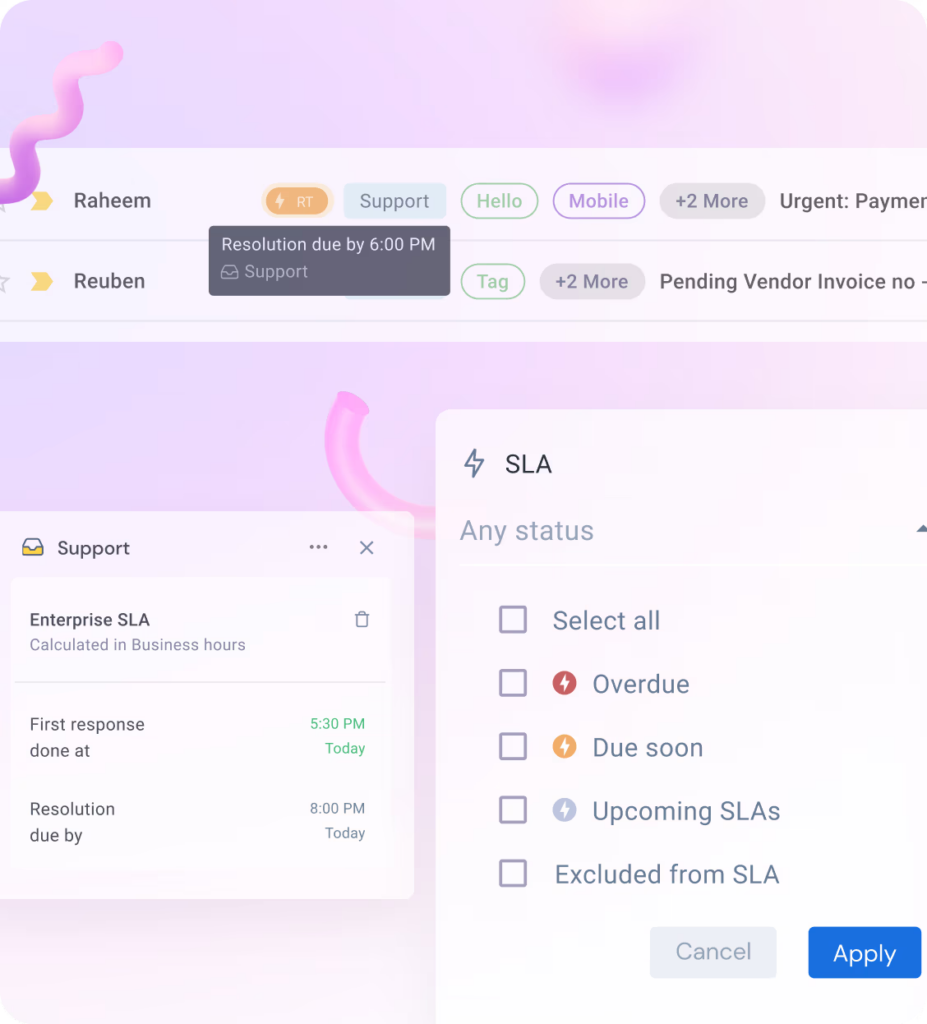7 Best Help Desk SLA Templates to Streamline Support

Table of contents
Service Level Agreements (SLAs) outline the expected support standards for a business’s help desk.
They detail what customers should expect in terms of response time and service quality, giving them assurance. For the support team, SLAs offer clear instructions on handling support requests.
For instance, if an SLA guarantees a response within twelve hours, customers know exactly when to expect an answer, which builds trust and reliability in your services.
Help desk SLA templates make it easier to draft these important agreements.
With these templates, businesses can better manage how customer expectations are set and met, improving the efficiency of help desk operations.
In this blog, we’ll highlight seven top help desk SLA templates designed to streamline service processes.
What are Help Desk SLAs?
Help Desk Service Level Agreements (SLAs) are contracts that outline the quality and speed of service that a help desk should provide. These agreements specify how quickly support issues should be addressed and resolved, and set standards for the overall service quality.
They also include details about what happens if the service does not meet the agreed-upon standards, such as penalties or other corrective actions.
Provide Excellent Support with Hiver’s SLA Management and Tracking Feature
7 Help Desk Templates to Streamline Support Processes
Below are seven types of help desk SLA templates that’ll help you streamline support operations.
Template 1: Basic Response Time SLA
This template defines specific time frames for responding to support requests based on their priority level.
1. Agreement Overview:
This agreement represents a Service Level Agreement (“SLA” or “Agreement”) between the Company (Service Provider) and Customer for the provisioning of IT support services required to support and sustain the product or service.
2. Goals & Objectives:
The purpose of this Agreement is to ensure that the proper elements and commitments are in place to provide consistent IT service support and delivery to the Customer(s) by the Service Provider.
3. Stakeholders:
– Primary Stakeholders: IT Service Provider, Customer Service Department
– Secondary Stakeholders: All company employees and clients
4. Periodic Review:
This agreement is valid from the Effective Date outlined herein and is valid until further notice. This Agreement should be reviewed at a minimum once per fiscal year; however, in lieu of a review during any period specified, the current Agreement will remain in effect.
5. Service Scope:
The following Services are covered by this Agreement:
– Manned telephone support
– Monitored email support
– Remote assistance using a Remote Desktop and designated tools
6. Customer Duties:
To receive the services outlined in this SLA, the Customer agrees to:
– Provide all information needed for the Service Provider to complete the support.
– Notify the Service Provider of issues or problems in a timely manner.
– Comply with the service procedures and escalation policies.
7. Service Provider Duties:
The Service Provider will respond to service-related incidents and/or requests submitted by the Customer within the following time frames:
– Immediate Response Requests: within 1 hour (critical issues)
– High Priority Requests: within 4 hours (significant impact issues)
– Normal Priority Requests: within 24 hours (moderate impact issues)
– Low Priority Requests: within 72 hours (minor issues)
8. Service Management:
Effective support of in-scope services is a result of maintaining consistent service levels. The following sections provide relevant details on service availability, monitoring of in-scope services and related components.
9. Service Assumptions:
– Changes to services will be communicated and documented to all stakeholders.
– The Service Provider is not responsible for the failure of third-party services that impact service delivery under this SLA.
10. Penalties:
In the event that the Service Provider fails to meet the response times described above, specific penalties will be applied, typically in the form of service credits or a discount on future services.
Template 2: Comprehensive Support Coverage SLA
This template provides a more detailed and extensive framework for help desk support, covering response times, issue resolution times, and quality of service.
1. Agreement Overview:
This agreement specifies the comprehensive support obligations provided by the Service Provider to the Customer, ensuring all aspects of system and product support are covered comprehensively.
2. Goals & Objectives:
This agreement aims to provide a complete, all-encompassing IT support framework that ensures rapid, reliable, and effective resolution of IT issues.
3. Stakeholders:
– Primary Stakeholders: IT Service Provider, Customer Support Team
– Secondary Stakeholders: End Users, IT Management
4. Periodic Review:
This agreement will remain in effect until superseded or terminated. A formal review will occur annually or as otherwise agreed upon by the stakeholders.
5. Service Scope:
The following areas are included within the scope of this Service:
– 24/7 manned telephone support
– Guaranteed email response times
– On-site support as deemed necessary
– Remote system monitoring and management
6. Customer Duties:
Customers are required to:
– Report issues promptly through designated channels.
– Provide access to necessary resources and personnel for issue resolution.
– Follow agreed-upon procedures for requesting support and escalations.
7. Service Provider Duties:
The Service Provider commits to the following response and resolution times:
– Critical Issues: Response within 1 hour, resolution within 4 hours.
– High Impact Issues: Response within 2 hours, resolution within 8 hours.
– Moderate Impact Issues: Response within 4 hours, resolution within 24 hours.
– Low Impact Issues: Response within 24 hours, resolution within 3 days.
8. Performance Metrics:
Service performance will be measured through:
– Response time adherence.
– Resolution time effectiveness.
– Customer satisfaction ratings.
9. Issue Escalation:
In case of unsatisfactory resolution, issues will be escalated as follows:
– Level 1: Service Desk
– Level 2: Technical Supervisor
– Level 3: IT Manager
10. Amendments and Termination:
Any changes to this agreement must be made in writing and agreed upon by both parties. The Agreement may be terminated by either party with a 30-day written notice.
11. Penalties and Rewards:
Failure to meet agreed performance metrics will result in penalties, whereas exceeding them can result in rewards or bonuses for the Service Provider.
Template 3: Multi-Level Support SLA
This template is for organizations that deal with many types of support questions, from simple user queries to complex technical problems. It sets up different levels of support, each with clear response and resolution times, ensuring each inquiry is handled properly and efficiently.
1. Agreement Overview:
This SLA outlines the framework for the Service Provider’s multi-level support, ensuring that all customer inquiries are managed effectively according to their complexity and urgency.
2. Service Scope:
– Level 1 Support (Basic Help Desk): Handling general queries and common issues.
– Level 2 Support (Advanced Technical Support): Addressing more complex issues requiring specialized knowledge.
– Level 3 Support (Expert Technical Support): Resolving high-complexity problems, often involving system-level support or detailed technical expertise.
3. Customer Duties:
– Utilize the proper channels to escalate issues based on their nature.
– Provide detailed descriptions and the necessary documentation to facilitate swift issue resolution.
4. Service Provider Duties:
– Level 1 Support: Respond within 2 hours, resolve within 24 hours.
– Level 2 Support: Respond within 4 hours, resolve within 48 hours.
– Level 3 Support: Respond within 8 hours, resolve as per complexity (details to be specified based on the nature of the issue).
5. Performance Metrics:
Performance will be assessed based on:
– Adherence to response and resolution times at each support level.
– Accuracy and effectiveness of the problem resolution.
– Customer feedback and satisfaction surveys.
6. Issue Escalation Procedure:
If an issue is not resolved within the stipulated time at a certain level, it automatically escalates to the next level:
– From Level 1 to Level 2 after 24 hours.
– From Level 2 to Level 3 after 48 hours.
7. Amendments and Termination:
Changes to the SLA or termination require mutual consent and a written notice 30 days in advance.
8. SLA Management:
Regular SLA reviews and updates to ensure the support structure adapts to evolving business and technology needs.
Template 4: Vendor-Specific Support SLA
This template is for when your company’s support services are outsourced to a third-party vendor. For instance, IT support services are managed by an external IT service provider to handle hardware, software, and network issues. Or, customer call center – operated by a third-party to manage inbound and outbound customer calls.
1. Agreement Overview:
This SLA formalizes the vendor’s support services, detailing the scope and quality of service expected to maintain system efficiency and user satisfaction.
2. Service Scope:
– Software/Application Support: Maintenance and troubleshooting of specified software products.
– Hardware Support: Maintenance, repairs, and possibly replacement of specified hardware components.
– System Upgrades: Scheduled upgrades and patches as necessary.
3. Vendor Duties:
– Provide continuous monitoring and proactive maintenance to prevent issues.
– Respond to service incidents within the agreed timelines:
a) Critical Systems: Response within 1 hour, resolution within 4 hours.
b) Non-Critical Systems: Response within 4 hours, resolution within 24 hours.
– Supply regular performance and maintenance reports.
4. Customer Duties:
– Provide necessary access and cooperation to facilitate the vendor’s responsibilities.
– Notify the vendor promptly about any issues or irregularities in the system operations.
5. Performance Metrics:
– System uptime and reliability.
– Incident response and resolution times.
– Customer satisfaction levels and feedback.
6. Review and Adjustment:
– Regular review meetings to discuss service performance, challenges, and future requirements.
– Adjustments to the SLA terms based on mutual agreement during the review sessions.
7. Termination Clauses:
Either party may terminate the agreement with a 60-day written notice if service expectations are consistently unmet or the business requirements change significantly.
10 Best Vendor Management Software Solutions
Template 5: Network Uptime SLA
This template is designed to address the uptime requirements of network services, ensuring minimal downtime and maximum availability. It is particularly relevant for businesses that rely heavily on continuous network connectivity, such as those in e-commerce, telecommunications, and IT services.
1. Agreement Overview:
This SLA establishes the expected level of network availability provided by the service provider to ensure consistent access to network resources necessary for business operations.
2. Service Scope:
– Network Monitoring: Continuous monitoring of network performance.
– Proactive Support: Immediate action on potential disruptions identified through monitoring.
– Disaster Recovery: Implementation of recovery measures in case of major failures to minimize downtime.
3. Service Provider Duties:
– Maintain a network uptime of 99.9% monthly.
– Immediate notification and response to any disruptions that may affect network performance.
– Provide emergency support and rapid resolution for network outages.
4. Customer Duties:
– Report network issues immediately upon discovery.
– Collaborate with the service provider during troubleshooting and resolution processes.
– Ensure compatibility of internal systems with network updates and configurations.
5. Performance Metrics:
– Monthly network uptime percentage.
– Response time to initial outage reports.
– Average handling time for network disruptions.
6. Review and Adjustments:
– Quarterly network performance reviews, including analyzing any downtimes and remedial actions taken.
– Adjustments to network management strategies based on evolving business needs and technology advancements.
7. Penalties for Non-Compliance:
Credit allowances for downtime exceeding the agreed threshold, calculated as a percentage of the monthly service fee.
8. Termination Provisions:
Provision for contract termination if network uptime falls below the agreed threshold consistently over a three-month period.
Template 6: Cloud Service Performance SLA
This template is for businesses that utilize cloud services and require assurances about their performance and reliability. It focuses on defining service levels related to cloud infrastructure, including aspects such as server uptime, data accessibility, and system scalability.
1. Agreement Overview:
This SLA defines the standards for cloud service performance that the provider must meet to effectively support the customer’s business operations.
2. Service Scope:
– Server Uptime: Commitment to maintaining high availability of cloud servers.
– Data Accessibility: Ensuring that data stored in the cloud is accessible as per agreed standards.
– Scalability: The ability of cloud services to scale resources up or down based on business demand.
3. Service Provider Duties:
– Guarantee a server uptime of 99.95% on a monthly basis.
– Provide robust data backup and restore processes to ensure data integrity and availability.
– Offer scalable solutions that can be adjusted quickly to meet changing business needs.
4. Customer Duties:
– Report any performance issues or outages to the provider promptly.
– Ensure compliance with the provider’s usage policies and procedures.
– Regularly review and manage their resource requirements.
5. Performance Metrics:
– Compliance with the uptime and accessibility targets.
– Efficiency of the scaling processes.
– Customer satisfaction and service quality feedback.
6. Reporting and Communication:
– Monthly performance reports detailing uptime, incidents, and service disruptions.
– Regular communication for planned maintenance and system upgrades.
7. Penalties for Non-Compliance:
Service credits are provided for any month where service levels fall below the guaranteed performance metrics.
8. Termination Conditions:
The agreement may be terminated if the service provider fails to consistently meet the performance criteria over six months.
Template 7: Application-Specific Support SLA
This template is for organizations that need support for specific software applications to ensure they work well. It’s ideal for businesses like financial firms with trading platforms or healthcare providers with patient systems. The SLA focuses on keeping the software running smoothly, fixing issues, and supporting users to minimize any disruptions.
1. Agreement Overview:
This SLA outlines the service levels for supporting designated applications and details the provider’s support responsibilities to maintain optimal application performance.
2. Service Scope:
– Application Maintenance: Regular updates and maintenance to ensure application functionality.
– User Support: Dedicated support for application users, addressing usage questions and issues.
– Performance Monitoring: Ongoing monitoring to detect and resolve performance issues.
3. Service Provider Duties:
– Ensure application availability of 99.8% during business hours.
– Respond to any user support tickets within 2 hours during business hours.
– Resolve critical application issues within 4 hours.
4. Customer Duties:
– Provide detailed issue reports to facilitate quick resolutions.
– Keep application software up-to-date in line with provider recommendations.
– Train users to utilize the application according to best practices.
5. Performance Metrics:
– Application uptime and reliability.
– Response and resolution times for user inquiries and issues.
– User satisfaction ratings.
6. Reporting and Communication:
– Bi-monthly reports on application performance, including uptime statistics and issue logs.
– Immediate notification of critical incidents affecting application performance.
7. Penalties for Non-Compliance:
Compensation in the form of service credits for not meeting the specified service levels, particularly concerning uptime and resolution metrics.
8. Termination Conditions:
The agreement may be terminated with a 30-day notice if the provider repeatedly fails to meet the agreed service levels.
How Hiver’s SLA Feature Helps Support Teams
Hiver helps support teams set up and manage Service Level Agreements (SLAs) directly within their inbox.

It offers the following benefits:
- SLA-Based Reminders: Set reminders based on SLA deadlines to ensure timely responses and avoid breaches.
- Prioritized Email Management: View SLA statuses in email list views to better prioritize emails, focusing on those needing immediate attention.
- Clear SLA Distinctions: Easily differentiate between First Response Time and Resolution Time SLAs. This helps teams manage expectations and workflows more effectively.
- Quick Access to Conversation Status: Instantly see which conversations are overdue or due soon, facilitating quicker prioritization and escalation of critical issues.
- Multiple SLA Rules: Implement multiple SLA rules to effectively track and prioritize customer responses, ensuring critical issues are handled first.
Conclusion
Whether your goal is to manage simple inquiries or complex technical issues, the right SLA template can make a significant difference.
These seven templates listed above help ensure that every customer issue is addressed promptly and appropriately.
Implementing such frameworks streamlines workflows and helps support teams respond to customers more effectively.

































